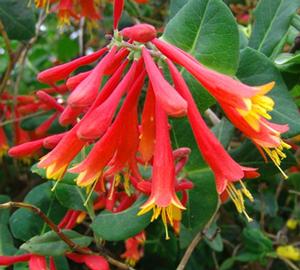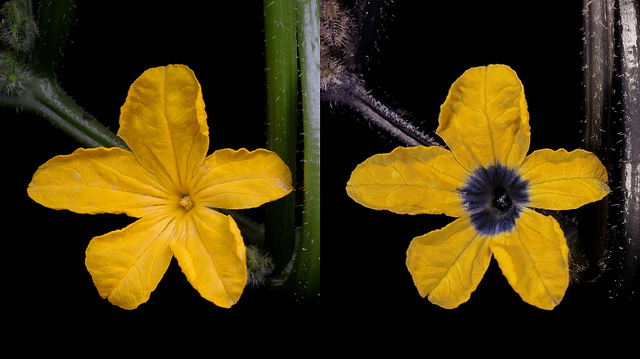For the most part, pollinators aren't visiting flowers for the pollen itself, it's the nectar they want. And in the process of getting that sugary goodness, they get pollen dusted on their bodies.
When that animal visits another flower, some of the pollen from the previous flower brushes off, and it picks up some more pollen, and the critter has become a pollinator without even knowing it. So, if a flower can attract an animal to its nectar, it will have a chance at passing on its pollen.
There are all sorts of animal pollinators that flowers recruit to help them spread their genes, from bees, butterflies, and beetles, to hummingbirds, bats, and ants (not ents). And what's so neat about the whole process is that the structure of flowers many times depends on the pollinators that are used to spread its pollen! Whether it's bright colors, scent, shape, or even arrangement, flowers do their best to entice a potential pollinator.
Color
Bright colors are often utilized to attract both insect and bird pollinators. Flowers that are pollinated most often by hummingbirds are generally red, orange, or a similar warm color. (These flowers are not frequented by bees, as they cannot see the color red.)
Scarlet sage (Salvia coccinea); a favorite among gardeners for attracting hummingbirds
In addition to bright colors, plants that attempt to attract insects also rely on markings that are known as bee guides as a kind of runway for insects. These are a flower's way of saying "This way to the nectar!" They can come in the form of lines leading to the center of the flower...
...or as a contrasting color, as in the case of this crested iris.
These yellow bee guides go all the way to the center of the flower.
Bee guides can also be invisible to our eyes, appearing in the ultraviolet spectrum, which bees can see.
On the left is a cucumber flower as we see it. On the right is the same flower under a UV light (with the yellow artificially colored), revealing the secret message intended for the eyes of bees.
Scent
Mammals have a highly developed sense of smell compared to other animal groups, so flowers pollinated by bats, for example, tend to have a strong scent.
Now don't take this to mean that because you have a garden full of sweet smelling flowers that you are going to be raided by bats. The flowers in our gardens have been artificially selected, bred, and cross-bred for their scents to attract another species: humans.
Shape
 Besides color, there's another way you can tell that a flower is trying to win the attention of hummingbirds, and that is by looking at its shape. Hummingbirds have long, narrow beaks to reach deep inside flowers, and so flowers that hummingbirds visit tend to be tube-shaped. The salvia I featured earlier is an example, as well as another favorite of mine which I currently have in my garden, coral honeysuckle. It always makes we wonder though; which came first, the tube-shaped flower, or the long beak?
Besides color, there's another way you can tell that a flower is trying to win the attention of hummingbirds, and that is by looking at its shape. Hummingbirds have long, narrow beaks to reach deep inside flowers, and so flowers that hummingbirds visit tend to be tube-shaped. The salvia I featured earlier is an example, as well as another favorite of mine which I currently have in my garden, coral honeysuckle. It always makes we wonder though; which came first, the tube-shaped flower, or the long beak?
Arrangement

 Take a look at these two flowers. Which do you think is more attractive to ants and other crawling insects? If you picked the goatsbeard on the right, you are thinking like an ant, my friend. Ants don't have the luxury of being able to fly from flower to flower like bees and butterflies, and so a plant that has many flowers clustered together is going to be an ant's preferred one-stop-shop for all of its nectar needs. When you see flowers like goatsbeard and goldenrod, take a moment to look at the incredible diversity of insects that these flowers attract. It's for this very reason that I have both of these plants in my garden.
Take a look at these two flowers. Which do you think is more attractive to ants and other crawling insects? If you picked the goatsbeard on the right, you are thinking like an ant, my friend. Ants don't have the luxury of being able to fly from flower to flower like bees and butterflies, and so a plant that has many flowers clustered together is going to be an ant's preferred one-stop-shop for all of its nectar needs. When you see flowers like goatsbeard and goldenrod, take a moment to look at the incredible diversity of insects that these flowers attract. It's for this very reason that I have both of these plants in my garden.
The next time you are in your backyard, visiting a nature center, or walking through a park, take a look at the flowers and see if you can guess what kind of animal might pollinate it. Once you see some of the patterns, it's almost like learning another language; you acquire the ability to "translate" the message that the flowers are sending to their potential pollinators. And if you smell a few flowers along the way? You just might pollinate some flowers with your nose!






No comments:
Post a Comment